Measurements and Instrumentation in the Stable Isotope Geochemistry Team

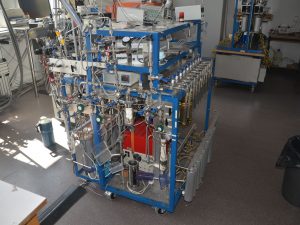
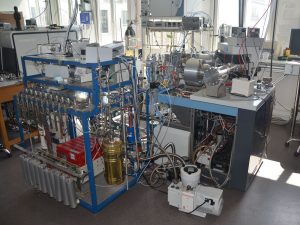
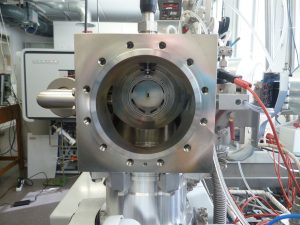
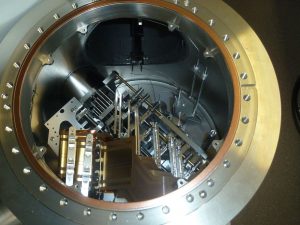
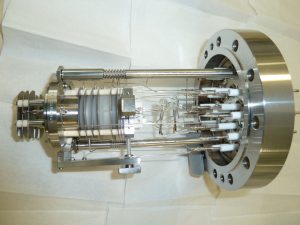
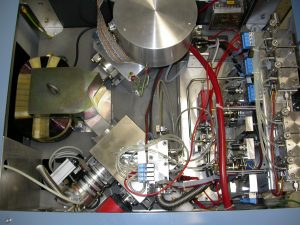
The precise and accurate measurement of isotopic abundances of light elements such as C, N, O, S, H, Cl, Br.. requires a transformation of the considered element into a gas molecule (e.g. N2 for nitrogen, CH3Cl for chlorine), before analysis using gas source mass spectrometry.
To implement our research projects, our team is équipped with :
- 2 mass spectrometer Thermo-Fisher MAT-253 (since 2005 and 2010, respectively)
- 1 mass spectrometer Thermo-Fisher Delta + XP (since 2004)
- 1 mass spectrometer Thermo-Fisher Delta V (since 2013)
- 1 helium continuous flow mass spectrometer Thermo-Fisher Delta V (since 2022)
- 1 rare gas-type mass spectrometer functionning in static mode (build by our team in the 90s).
- 1 helium continuous flow mass spectrometer (AP2003)
- 1 high-resolution gas source mass spectrometer (Thermo-Fisher MAT 253 ULTRA, since 2016).
13 vacuum lines allowing extraction, gas reactions, purification and quantification of the element under consideration.
Various devices and equipments (Gas Bench, Flash-EA, GC-C, Pyrocube), infra-red spectrometer (Thermo Nicolet 550), Micro-Milling system (New Wave Research), batch reactor for hydrothermal HP-HT experiments (0-500 bars/25-300°C), furnaces, induction heating system, IR and UV laser…
Many other equipments are also available in other research teams of our Institute.
We thank our numerous partners for financial supports (e.g. CNRS, La Région Ile-de-France, Total, Schlumberger, ADEME, Mairie de Paris, University Paris-Diderot and Institut de Physique du Globe).
Here are the different analysis that we are able to perform in our team :
Scientific coordinator: Magali Bonifacie
The analysis of the ∆47 of carbonates consists in the measurement of the overabundance of the 13C–18O chemical bounds (relative to a stochastic distribution) in gaseous CO2 produced via acid digestion of carbonates. The abundance of the 13C–18O bounds inside the carbonate lattice increases at low temperature and only depends on their temperature of crystallization or equilibration, thus providing a reliable paleo-thermometer.
Field of research and associated publications
– Refinement of the accuracy of the ∆47 thermometer and of its interpretationnal foundations (Bonifacie et al., 2017, Katz et al., 2017, Mangenot et al., 2017, Dassié et al., 2018, Pettersen et al., 2019, Bernasconi et al., 2021, Anderson et al., 2021, Huntington et al., 2011)
– Carbonate diagenesis (Bristow et al., 2011, Mangenot et al., 2017, Mangenot et al., 2018 a and b, Pagel et al., 2018, Bennet et al., 2018, Dassié et al., 2018, Fay-Gomord et al., 2018, Brigaud et al. 2020, Loyd et al., 2015, Kirschvink et al. 2015)
– Biomineralization (Katz et al., 2017, Thaler et al., 2020)
– High temperature clumped isotope thermometry (Bristow et al., 2011, Bonifacie et al. 2017, Mangenot et al., 2019)
Analytical performance
Since 2013, we are routinely analyzing any type of carbonate (calcite, aragonite, dolomite…) with a precision better than ±0.014‰ (1 SD for 3 replicates). Each analysis requires 5 mg of carbonate powder. The measurement of ∆47 is performed using a Thermo MAT 253 mass spectrometer after CO2 extraction via H3PO4 digestion of carbonates, and purification of CO2 on vacuum line.
List of publications
* Publication with data out of the IPGP laboratory
Student supervised
# Community papers
2021
#* Anderson N.T., Kelson J.R., Kele S., Da¨eron M., Bonifacie M., Horita J., Mackey T.J, John., C.M., Kluge T., P. Petschnig11, Jost A.B., Huntington K.W, Bernasconi ., S.M., Bergmann K.D. A unified clumped isotope thermometer calibration (0.5–1100°C) using carbonate-based standardization In press GRL
#* Bernasconi S.M., Daëron M., Bergmann K.D., Bonifacie M., Meckler A.N., Affek H.P., Anderson N., Bajnai D., Barkan E., Beverly E., Blamart D., Burgener L., Calmels D., Chaduteau C.,. Clog M., Davidheiser-Kroll B., Davies A., Dux F., Eiler J., Elliott B., Fetrow A. C., Fiebig J., Goldberg S., Hermoso M., Huntington K.W., Hyland E., Ingalls M., Jaggi M., John C.M., Jost A. B., Katz S., Kelson J., Kluge T., Kocken I.J., Laskar A., Leutert T.J., Liang D., Lucarelli J., Mackey T. J., Mangenot X., Meinicke N., Modestou S.E., Müller I.A., Murray S., Neary A., Packard N., Passey B.H., Pelletier E., Petersen S., Piasecki A., Schauer A., Snell K.E., Swart P.K., Tripati A., , Upadhyay D., Vennemann T., Winkelstern I., Yarian D., Yoshida N., Zhang N., Ziegler M. InterCarb: A community effort to improve inter-laboratory standardization of the carbonate clumped isotope thermometer using carbonate standards In press Geochemistry, Geophysics, Geosystem
2020
* Thaler C., Katz A., Bonifacie M., Ménez B., Ader M. Oxygen isotope composition of waters recorded in carbonates in strong clumped and oxygen isotopic disequilibrium (2020). Biogeosciences, 17, 1–14, 2020. DOI 10.5194/bg-17-1731-2020
* Brigaud B., Bonifacie M., Pagel M., Blaise T., Calmels D., Haurine F., Landrein P. Past hot fluid flows in limestones detected by ∆47/(U-Pb) and not recorded by other geothermometers, Geology, May 2020, Vol.48,851-856.
2019
#* Petersen S.V., Defliese W.F., Saenger C., Daëron M., John C.M., Huntington K.W., Kelson J.R., Bernasconi S.M., Colman A.S., Kluge T., Olack G.A., Schauer A.J., Bajnai D., Bonifacie M., Breitenbach, S.F.M., Fiebig J., Fernandez A.B., Henkes G.A., Hodell, D., Katz A., Kele S., Lohmann K.C., Passey B.H., Petrizzo D.A., Rosenheim B.E., Tripati A.E., Venturelli R., Young E.D., Wacker U., and Winkelstern I.Z., Effects of Improved 17O Correction on Inter-Laboratory Agreement in Clumped Isotope Calibrations, Estimates of Mineral-Specific Offsets, and Acid Fractionation Factors Geochemistry, Geophysics, Geosystem 20 (7) 3495-3519. DOI: 10.1029/2018GC008127.
* Mangenot X., Deconinck J.F, Bonifacie M., Sizun J.P., Colin P.Y., Quesnes D., Charollais J., Rouchon V. (2019). Thermal and exhumation histories of the northern subalpine chains (Bauges and Bornes—France): Evidence from forward thermal modeling coupling clay mineral diagenesis, organic maturity and carbonate clumped isotope (Δ47) data, Basin Research 31 (2) 361-379 DOI: 10.1111/bre.12324
2018
* Mangenot X., Gerdes A., Gasparrini M., Bonifacie M., Rouchon V. An emerging thermo-chronometer for carbonate-bearing rocks : Δ47/(U-Pb). Geology 46 (12), 1067-1070. Doi: 10.1130/G45196.1
* Fay-gomord O., Allanic C., Wouter S., Honlet R., Champenois F., Bonifacie M., Chaduteau C., Muchez P., Verbiest M., Lasseur E., Swennen R. (2018) Understanding fluid-flow during tectonic reactivation: an example from the flamborough head chalk outcrop (UK) Geofluids, Article ID 9352143, 17 pages. DOI : 10.1155/2018/9352143/
* Bennett, C. E., Williams, M., Leng, M. J., Lee, M. R., Bonifacie, M., Calmels, D., Fortey, R.A., Laurie, J.R., Owen, A. W., Page A.A., Munnecke A.,Vandenbroucke, T.R.A. (2018) Oxygen isotope analysis of the eyes of pelagic trilobites: testing the application of sea temperature proxies for the Ordovician. Gondwana Research, 57, 157-169
* Dassié E. Genty, D., Noret, A., Mangenot, X., Massault, M., Lebas, N., Duhamel, M., Bonifacie, M., Gasparrini, M., Minster B., and Michelot, J.L. (2018) A newly designed analytical line to examine the reproducibility of fluid inclusion isotopic compositions in small carbonate samples. Geochemistry, Geophysics, Geosystems, 19 (4) 1107-1122. DOI: 10.1002/2017GC007289
* Pagel M., Bonifacie M., Schneider D.A., Gautheron C., Brigaud B., Calmels D., Chaduteau C., Cros A., Saint-Bezar B., Landrein P., Davis D. (2018) Improving paleohydrological and diagenetic reconstructions in calcite veins and breccia of a sedimentary basin by combining Δ47 temperature, δ18Owater and U-Pb age. Chemical Geology 487, 1-17. DOI: 10.1016/j.chemgeo.2017.12.026
* Mangenot X., Gasparrini M., Rouchon V., Bonifacie M. (2018) Basin-scale thermal and fluid-flow histories revealed by clumped isotope (Δ47) – Middle Jurassic reservoirs of the Paris Basin. Sedimentology Vol. 65 (1), 123-150. DOI: 10.1111/sed.12427
2017
* Mangenot X., Bonifacie M., Gasparrini M., Goetz A., Ader M., Chaduteau C., Rouchon V. Coupling Δ47 and fluid inclusion thermometry on carbonate cements to precisely reconstruct the temperature, salinity and δ18O of paleo-groundwater in sedimentary basins. (2017) Chemical Geology 472, 44–57. DOI : 10.1016/j.chemgeo.2017.10.011
* Katz A., Bonifacie M., Hermoso M., Cartigny P., Calmels D. (2017) Laboratory-grown coccoliths exhibit no vital effect in clumped isotope (Δ47) composition on a range of geologically relevant temperatures Geochimica Cosmochimica Acta , 208, 335–353. DOI :10.1016/j.gca.2017.02.025
* Bonifacie M., Calmels D., Eiler J.M., Horita, J., Chaduteau C., Vasconcelos, C., Agrinier, P., Katz A., Passey, B.H., Ferry J.M., Bourrand J.J. (2017) Experimental calibration of the dolomite clumped isotope thermometer from 25 to 350°C, and implications for a universal calibration for all (Ca, Mg, Fe)CO3 carbonates. Geochimica Cosmochimica Acta, 200, 255-279. DOI : 10.1016/j.gca.2016.11.028
2015
Loyd S., Corsetti F., Eagle R.A., Hagardorn J.W., Shen Y., Zhang X. Bonifacie, M., Tripati A. K. 2015. Origins of the Neoproterozoic Wonoka-Shuram anomaly from clumped isotope paleothermometry, Precambrian Research 264, 179-191.
Kirschvink J., Isozaki Y., Shibuya H., Raub T., Hilburn I., Yokoyama M., Bonifacie, M. Challenging the sensitivity limits of Paleomagnetism: Magnetostratigraphy of Weakly-Magnetized Guadalupian-Lopingian (Permian) Limestone from Kyushu, Japan, Palaeogeography, Palaeoclimatology, Palaeoecology, 418, 75–89.
2011
Bristow, T.F., Bonifacie, M., Derkowski, A. Eiler, J. M. Grotzinger, J.P. 2011 A hydrothermal origin for isotopically anomalous cap dolostone cements from south China, Nature, 474, 68-71.
2009
Huntington, K., Eiler J., Affek H., Bonifacie, M., Guo, W., Yeung L., Thiagarajan N., Passey B., Tripati, A., Daeron M., Came R. 2009 Methods and limitations of analyses of « clumped » CO2 isotopes (D47) by gas source isotope ratio mass spectrometry, Journal of Mass Spectrometry, 44, 1318-1329.
In 2017 we have co-organized the VIth International Clumped Isotope Workshop at IPGP https://www.ipgp.fr/en/iciw
For further information, feel free to contact Magali Bonifacie
Scientific coordinator : Magali Bonifacie
Lab Manager : Gérard Bardoux
- The Chlorine stable isotope
The Chlorine stable isotope lab at IPGP has been founded in the early 2000’s, at the very beginning of the emergence of this new geochemical tool, and thus has largely participated to the worldwide current knowledge on Cl isotope systematics. Since then, our high analytical performances ay IPGP have allowed to encompass a broad field of research.
Field of research led at IPGP and associated publications
– The geodynamic cycle of chorine (Bonifacie et al., 2005, 2007a et b, 2008a et b)
– Magmatism, volcanism, hydrothermalism (Bonifacie et al., 2005, Bonifacie et al., 2007, Bonifacie et al., 2008a, Li et al., 2015, Manzini et al., 2017, Stephan et al., 2020, Benard et al., 2021)
– Transport processes in fluids (Godon et al. 2004b, Lavastre et al. 2005, Woule Ebongue 2005, Bonifacie et al 2007, Bernachot et al., 2017; Giunta et al., 2017, Agrinier et al., 2019, Agrinier et al., 2021)
– Method development for chlorine and bromine measurements in various materials (Bonifacie et al., 2007, Giunta et al. 2015, Louvat et al. 2015, Gilevska et al., 2015, Horst et al., 2019)
– Determination of isotopic fractionation (Eggenkamp et al., 2016, Giunta et al., 2017, Agrinier et al., 2021)
– Standardisation for accurate δ37Cl measurements (Godon et al. 2004a, Bonifacie et al., 2007, Gilevska et al., 2015, Manzini et al., 2017, Wudarska et al., 2021, etc)
– Evaporites (Eggenkamp et al., 2019a, 2019b)
Analytical performances
Chlorine isotope compositions (ratio 37Cl/35Cl) of fluids and gases) are routinely measured with high analytical precision of ±0.03‰ (1SD) for samples containing ≥ 180 µg Cl. Smaller samples can be analyzed with lower precision.
The chlorine isotope analyses require a transformation of chlorides into gaseous CH3Cl, which is then analyzed with a Thermo Fisher Delta V mass spectrometer.
For rock samples, a first step requires the extraction of Cl contained in the sample via pyrohydrolysis and transformation into chlorides (details in Bonifacie et al., 2007).
Lab’s publications (δ37Cl data out of IPGP lab only)
Lab members (permanent or transitory) are in bold font.
Wudarska, A.; Słaby, E.; Wiedenbeck, M.; Barnes, J.D.; Bonifacie, M.; Sturchio, N.C.; Bardoux G. Coufignal, F.; Glodny, J.; John, T.; Kusebauch, C.; et al. (2021) Inter-Laboratory Characterization of Apatite Reference Materials for Chlorine Isotope Analysis. Geostandard and Geoanalytical Research. doi: 10.1111/ggr.12366
Muller E. et al. (dont Bardoux G. and Ader M.) The origin of continental carbonates in Andean salars: A multi-tracer geochemical approach in Laguna Pastos Grandes (Bolivia). Geochimica Cosmochimica Acta, 279, 220-237. DOI: 10.1016/j.gca.2020.03.020
Benard, B., Famin, V., Agrinier, P., Aunay, B., Lebeau, G., Sanjuan, B., Vimeux, F., Bardoux, G., Dezayes, C., 2020. Origin and fate of hydrothermal fluids at Piton des Neiges volcano (Réunion Island): A geochemical and isotopic (O, H, C, Sr,Li, Cl) study of thermal springs. Journal of Volcanology and Geothermal Research, 382, 1-36. https://doi.org/10.1016/j.jvolgeores.2019.106682
Horst A., Bonifacie M., Bardoux G., Richnow H.H. Isotopic characterization (2H, 13C, 37Cl, 81Br) of the abiotic sinks of methyl bromide and methyl chloride in water and implications for future studies (2019). Environmental Science and Technology, 53 (15), 8813-8822. DOI: 10.1021/acs.est.9b02165
Stephant A., Anand M., Zhao X., Chan Q., Bonifacie M., Franchi I. The chlorine isotopic composition of the Moon: Insights from melt inclusions, Earth and Planetary Science Letters 523 (2019) # 115715. DOI: 10.1016/j.epsl.2019.115715
Eggenkamp HGM, Louvat P, Agrinier P., Bonifacie M., Bekker A., Griffioen J., Horita J., Brocks JJ, Bagheri R. (2019). The bromine and chlorine isotope composition of primary halite deposits and its consequence for the historical isotope composition of seawater, Geochimica Cosmochimica Acta, 264, 13-29. DOI: 10.1016/j.gca.2019.08.005
Agrinier P. Destrigneville, C., Giunta, T., Bonifacie, M., Bardoux, G., André J., Lucazeau, F. (2019). Chlorine stable isotope ratios (35Cl/37Cl) of chlorides of fluids produced in low permeability clay rich sediments: the potential role ion-filtration. Geochimica Cosmochimica Acta, 245, 525-541 DOI: 10.1016/j.gca.2018.11.013
Giunta T., Devauchelle O., Ader M., Locke R., Louvat P., Bonifacie M., Métivier F., Agrinier P. The gravitas of gravitational isotope fractionation revealed in an isolated aquifer. (2017) Geochemical Perspective Letters 4, 53-58. DOI:10.7185/geochemlet.1736.
Giunta T., Labidi J. Eggenkamp H., (2017) Chlorine isotope fractionation between chloride (Cl–) and dichlorine (Cl2) Geochimica Cosmochimica Acta, 213, 375-382 http://dx.doi.org/10.1016/j.gca.2017.07.003
Bernachot, I., Garcia, B., Ader, M., Peysson, Y., Rosenberg E., Bardoux, G., Agrinier, P., 2017. Solute transport in porous media during drying: The chlorine isotopes point of view. Chemical Geology, 466, 102-115 http://dx.doi.org/10.1016/j.chemgeo.2017.05.024
Manzini M., Bouvier A.-S., Barnes J., Bonifacie M., Rose-Koga E. F., Ulmer P., Métrich N., Bardoux G., Williams J., Layne G.D., Straub S., Sharp Z., Baumgartner L.P. John, T. (2017) SIMS chlorine isotope determination in melt inclusions from arc settings. Chemical Geology 449, 112–122. http://dx.doi.org/10.1016/j.chemgeo.2016.12.002
Ivdra N., Fischer A., Herrero-Martin S., Giunta T., Bonifacie M., Richnow H.H. Carbon, hydrogen and chlorine stable isotope fingerprinting for forensic investigation on Hexachlorocyclohexanes. (2017) Environ. Science & Technology 51, 446-454. DOI: 10.1021/acs.est.6b03039.
Bonifacie M. Chlorine Isotopes (2017). In Encyclopedia of Geochemistry – Editor William White, Publisher Springer
Louvat P., Bonifacie M., Giunta T., Michel A. Coleman M. Determination of Bromine stable isotope ratios from saline solutions by « wet plasma » MC-ICPMS including a compaison between high- and low-resolution modes, and three introduction systems. 2016. Analytical Chemistry 88 (7), 3891-3898. DOI: 10.1021/acs.analchem.6b00062
Eggenkamp H., Bonifacie M., Ader M., Agrinier P. Experimental determination of stable chlorine and bromine isotope fractionation during precipitation of salt from a saturated solution. 2016. Chemical Geology 433, 46-56. http://dx.doi.org/10.1016/j.chemgeo.2016.04.009
Giunta T., Ader, M., Bonifacie, M., Agrinier, P., Coleman, (2015) M. Pre-concentration of chloride in dilute water-samples for precise δ37Cl determination using a strong ion-exchange resin, Chemical Geology 413, 86–93 10.1016/j.chemgeo.2015.08.019
Gilevska T., Ivdra N., Bonifacie M., Richnow H.H. 2015. Optimization of organochlorines’ conversion for Cl DI-IRMS measurements (2015). Rapid Communication in Mass Spectrometry 29, 1343–1350. DOI: 10.1002/rcm.7220
Li, L., Bonifacie, M., Aubaud C., Crispi O., Dessert C., Agrinier P. (2014) Chlorine isotopes in thermal springs of arc volcanoes for tracing shallow volcanic activity, Earth and Planetary Science Letters 413, 101-110. http://dx.doi.org/10.1016/j.epsl.2014.12.044
Bonifacie, M., N. Jendrzejewski, P. Agrinier, E. Humler, M. Coleman, M. Javoy, 2008 The chlorine isotope composition of the Earth’s mantle, Science, Vol. 319. no. 5869, 1518 – 1520. 10.1126/science.1150988
Bonifacie, M., V. Busigny, P. Philippot, C. Mével, P. Agrinier, M. Scambelluri, N. Jendrzejewski, M. Javoy 2008 Chlorine isotopic composition in seafloor peridotites and high-pressure metaperidotites: insights into the oceanic serpentinization and subduction processes, Geochim. Cosmochim. Acta, 72, 1, 126-139. doi:10.1016/j.gca.2007.10.010
Bonifacie, M., Jendrzejewski N., Agrinier P., Coleman M., Pineau F., Javoy M.; Pyrohydrolysis-IRMS determination of silicate δ37Cl compositions: application to oceanic crust and meteorite samples, Chem. Geology, 242, (2007; 187-201. doi:10.1016/j.chemgeo.2007.03.012
Bonifacie, M., C. Monnin, N. Jendrzejewski, P. Agrinier, M. Javoy, Chlorine stable isotopic composition of basement fluids of the Eastern flank of the Juan de Fuca ridge (ODP Leg 168), EPSL. 260, 1-2 (2007); 10-22. doi:10.1016/j.epsl.2007.05.011
Lavastre, V., Jendrzejewski, N., Agrinier, P., Javoy, M., Evrard, M., 2005. Chlorine transfer out of a very low permeability clay sequence (Paris Basin, France): 35Cl and 37Cl evidence. Geochim. Cosmochim. Acta 69, 4949–4961. doi:10.1016/j.gca.2005.04.025
Woulé Ebongué, V., Jendrzejewski, N., Walgenwitz, F., Pineau, F., Javoy, M., 2005. Chlorine isotope residual salt analysis (Cl-RSA): a new tool to investigate formation waters from core analyses. AAPG Bulletin, Geological Note, vol. 89, pp. 1005–1018. DOI:10.1306/03100504040
Bonifacie, M., Charlou J.L., Jendrzejewski N., Agrinier P., J.P. Donval. Chlorine isotopic compositions of high temperature hydrothermal vent fluids over ridge axes Chem. Geology, 221 (2005); 279-288. doi:10.1016/j.chemgeo.2005.06.008
Godon, A., Jendrzejewski, N., Castrec-Rouelle, M., Dia, A., Pineau, F., Boulègue, J., Javoy, M., 2004b. Origin and evolution of fluids from mud volcanos in the Barbados accretionary complex. Geochim. Cosmochim. Acta 68, 2153–2165. doi:10.1016/j.gca.2003.08.021
Godon, A., Jendrzejewski, N., Eggenkamp, H.G.M., Banks, D.A., Ader, M., Coleman, M.L., Pineau, F., 2004a. A cross-calibration of chlorine isotopic measurements and suitability of seawater as the international reference material. Chem. Geol. 207, 1–12. doi:10.1016/j.chemgeo.2003.11.019
Review article
Bonifacie M. Chlorine Isotopes (2017). In Encyclopedia of Geochemistry – Editor William White, Publisher Springer
PhD thesis and students
Arnaud Godon 2001
Véronique Lavastre 2001
Véronique Woulé Ebongué 2004
Magali Bonifacie 2005
Thomas Giunta 2015
Isabelle Bernachot 2017
Etienne Le Glas PhD expected for 2023
Laetitia Guibourdenche PhD expected for 2022
- Bromine isotope
Bromine isotope composition (81Br/79Br) of fluids can be measured by two different techniques depending on the sample size and chemical characteristics:
– Gas source mass spectrometry: bromide dissolved in solution must be transformed into CH3Br (gaseous form), which can be analyzed on the mass spectrometer (Delta Plus XP, Delta V). Prior to isotope analysis, Br is separated from Cl (with Cl/Br ratio of ~300 in natural samples). The ratio 81Br/79Br can presently be measured using IRMS with an external analytical precision of 0.1‰ (2SD), for an amount of 3-4 mg of Br.
– MC-ICP-MS : the ratio 81Br/79Br is measured ny MC-ICP-MS with a precision ranginf from 0.1 to 0.5 ‰ (2SD) for low amount of Br (10-50 µg). We are developping a new protocol for bromine chemical extraction using chromatography, allowing us to separate efficiently Br from Cl in highly enriched matrix such as seawater (the ratio Cl/Br of ~300 is lowered to 10).
For further information, feel free to contact Magali Bonifacie, Gérard Bardoux.
Since the 1980s, our team has put strong effort in the development of nitrogen isotope analysis (ratio 15N/14N) on very small samples, down to 1000 times lower than usual conditions. We have been able to routinely measure isotope composition of only few nanomoles of nitrogen, included in different types of matrix (diamonds, anthracite, graphite, organic matter, silicates…) with a precision better than ±0.5 ‰ (2 SD).
The analysis of very small samples is performed on our static mass spectrometer after online gas extraction. Another vacuum line is available and allows the preparation of sealed tubes for N analysis in various sample types. The sample size is typically of few mg (diamonds, graphite, anthracite) to few tens of mg (silicates).
The isotope composition of samples enriched in nitrogen, such as organic matter-rich sediments, is routinely measured via elemental analyzer (few mg of samples) and/or other extraction lines specifically designed for N-rich samples (> 1 μmol of nitrogen) and mass spectrometry (Delta Plus XP). The external reproducibility of samples and standards typically around ± 0.3 ‰ (2 SD).
For further information, feel free to contact Magali Ader, Vincent Busigny, Pierre Cartigny et Virginia Rojas.
Carbon isotope composition (ratio 13C/12C) of many samples (sediments, metasediments, rocks from altered oceanic crust, soils, particles…) are routinely measured for two different carbon species, organic carbon (reduced form) and carbonates (oxidized form). Both species are analyzed specifically, although bulk-rock analysis is also possible. We also analyze the isotope composition of dissolved inorganic carbon in terrestrial fluids (hydrothermal systems, lakes, rivers).
The analysis of organic carbon generally requires a sample treatment under acidic conditions (HCl) in order to remove any carbonate present in the sample. The analysis is then performed on the solid-residue of acid digestion, by a sealed-tube combustion technique or elemental analyser coupled to a mass spectrometer (Delta Plus XP, Delta V).
The carbonates (calcite, dolomite, magnésite, ankérite, sidérite) are generally analyzed by He continuous flow mass smectrometry (AP2003), after carbon extraction and transformation into CO2 by H3PO4 acidification.
For samples with low C concentration, such as those from oceanic crust (typically containing few hundred’s of ppm CO2), we developped a step-heating technique for C extraction, using either pyrolisis of combustion, at temperature ranging from 250 to 1100°C. This type of analysis requires only low amount of rock powder (50 to 100mg), and is thus also suitable for small size samples such as those produced during laboratory experiments. Carbon isotopes of diamonds are also routinely analyzed by combustion on samples generally between 0.02 to 3 mg.
The analytical precision on C isotope composition is typically of ± 0.03 ‰.
For analysis of dissolved inorganic carbon (DIC) in fluids, a technique was developped allowing extraction of dissolved C species in the form of CO2 by sample acidification using H3PO4. The gas is analyzed on our He continuous flow mass spectromer with a precision better than ±0.1 ‰ for DIC > 1mM, and a precision of about ±0.3 ‰ for DIC < 0.5 mM.
For further information, feel free to contact Magali Ader, Isabelle Martinez, Vincent Busigny, Magali Bonifacie, Cyril Aubaud, Pierre Cartigny, Virginia Rojas and Nelly Assayag.
Hydrogen isotope (D/H ratio) compositions of rocks are measured, after extraction (heating) under vacuum and reduction on hot uranium at 800°C. The quantities of hydrogen are generally about tenth of micromoles of H2, corresponding for instance to 300 mg of glass for concentration of ~ 2500 ppm H2O. The analytical precision is about ±3 ‰.
We can also measure water samples (e.g. for calibration of uranium furnaces) but the analyses are not optimized for large sample set.
For further information, feel free to contact Cyril Aubaud and Pierre Agrinier.
Oxygen isotope composition (ratios 17O/16O and 18O/16O on the molecule O2) of silicates and oxides can be measured in our laboratory by fluorination (F2, BrF5) in classical nickel bombs or fluorination coupled to laser ablation. The typical sample size is respectively 10 mg and 2 mg, and the analysis by mass spectrometry (MAT 253, Delta Plus XP or Delta V) provides precisions of about ±0.07 and ±0.02 ‰ (2 SD) respectively for δ18O and ∆17O.
The ratio 18O/16O in water samples is routinely measured using a technique based on CO2 equilibration with water, and He continuous flow mass spectrometry (via either GasBench or AP2003). The analysis is performed on water samples of ~1 mL, and gives a precision better than ± 0.2 ‰ on the δ18O value.
The isotope ratio 18O/16O of carbonates is analyzed, together with C isotopes (see “Analysis of carbon isotope composition) on sample powders of ~2 mg (for pure carbonates). The technique is based on sample acidification using H3PO4 allowing CO2 gas extraction. Then, the CO2 is analyzed by He continuous flow mass spcetrometry (AP2003) with a precision of ± 0.1 ‰ (2 SD).
For further information, feel free to contact Pierre Agrinier, Cyril Aubaud, Pierre Cartigny y Nelly Assayag.
Sulphur isotope compositions (33S/32S, 34S/32S et 36S/32S on the SF6 molecule) of sulphides, sulphate, organic or dissolved sulphur in glasses is carried out after extraction/chemical conversion to silver sulphide (Ag2S) and fluorination in nickel bombs, cryogenic and gas chromatography purification, and analysis by mass spectrometry (MAT 253).
The amounts required are, routinely, > 6 μmol (1.5 mg Ag2S) but we have successfully analysed samples down to 0.1 μmol (for 33S/32S, 34S/32S and 36S/32S) and are completing the validation of a protocol for analysis of a few nanomoles (for 33S/32S, 34S/32S ratios).
The analysis of sulphates and sulphides or organic sulphur (34S/32S) is also possible by an elemental analyser coupled to the mass spectrometer (Delta Plus XP).
For further information, feel free to contact Jabrane Labidi and Pierre Cartigny.
The GIS group is equipped with a Picarro L2140-i laser spectrometer for the measurement of the isotopic composition of water ((δ 18O, δ 17O, δD). The measurement is done by vaporization of a liquid water sample with a volume of 1-2 ml. The isotopic composition of water is used as a tracer of a very large number of processes of interest to the Earth Sciences.
Multiple applications include:
- the formation of hydrated minerals by evaporation from seawater
- tracing the continental hydrological cycle
- the functioning of volcanoes and hydrothermal systems
The Picarro L2140-i laser spectrometer is part of the High-Resolution Analysis Platform of IPGP (PARI platform).
For further information, feel free to contact Giovanni Aloisi.



